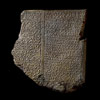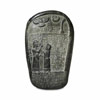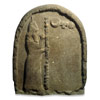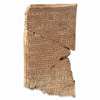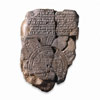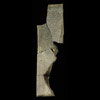
Translation of artifacts provided courtesy
of:
The British Museum 2003
|
MORE ARTICLES: VIDEO - THE FLOOD TABLET (real player format) Sumerian Culture and the Anunnaki |
Stela of Nabonidus
Neo-Babylonian dynasty, 555-539 BC
Possibly from Babylon, southern Iraq
The last king of the Neo-Babylonian Empire
It is not known where this basalt stela was
originally found, but it may come from Babylon. Comparison with other
sculptures, on which he is named, suggest that it represents King Nabonidus.
He wears the traditional dress of a Babylonian king, and holds a standard
which was possibly carried during a religious ceremony. Above him are
the divine symbols of the moon-god, Sin, (closest to him), the planet
Venus of Ishtar and the winged disc of the sun-god Shamash. The text celebrates
the return of plenty after a drought.
Nabonidus was the last king of the Neo-Babylonian Empire, which stretched
from the border of Egypt to the Gulf. He was not a member of the royal
family but came to the throne after the legitimate ruler had been murdered.
Keen to show his legitimacy, Nabonidus undertook major building works.
One of his projects was in the city of Harran where the temple of the
god Sin was rebuilt. He appears to have been devoted to this god, and
it is probable that his mother had been a priestess of Sin at Harran.
Another text of Nabonidus records her death and explains that she lived
to be over a hundred.
Height: 58 cm M. Roaf, Cultural atlas of Mesopotamia
and the Ancient Near East (New York, 1990), p. 201
H.W.F. Saggs, Babylonians (London, The British Museum Press, 1995),
p.168, fig. 82
Width: 46 cm
Thickness: 25 cm
